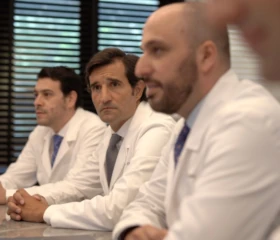Symptoms and causes Kidney Stones
85-90% of stones are associated with diet and lifestyle habits.
Most people who suffer from kidney stones are asymptomatic. That is why, until they do not move inside the kidney or come out of it, appearing the well-known nephritic colic, they are not aware of it.
- Super-specialized urologists
- Personalized treatment
- Minimally invasive approach
- More than 16,000 patients successfully treated
Symptoms of Kidney Stones
Most people who suffer from kidney stones are asymptomatic. That is why, until the stones or calculi do not move inside the kidney or come out of it -appearing the well-known nephritic colic- they are not aware that they have them.
The typical pain associated with kidney stones is that of nephritic colic. This pain that everyone has heard of, which begins suddenly in the lumbar region, radiates to the genital or abdominal area and may be associated with the presence of nausea or vomiting, occurs when a stone is mobilized, obstructing the outflow of urine from the kidney. This is undoubtedly the fundamental symptom of stone presentation. In fact, it does not have to be only a kidney stone, it can be in another location such as the ureter, which is the most common. The pain of nephritic colic is usually relieved or reduced by applying heat or hot water immersion baths. Unlike the pain of lumbago, back pain or muscle contracture, the pain of colic is not modified by changing position.
Within the symptomatology that produces the renal calculus, it can also arise:
- Fever, due to an associated infection.
- Nausea.
- Vomiting.
- Sweating, associated with nausea.
- Hematuria (blood in the urine), due to stone mobilization.
Causes of Kidney Stones
Fundamentally, 85-90% of stones are associated with diet and lifestyle habits in the western world today. We drink little amount of water and more amount of other substances that can dehydrate or that have a lot of sugar, favoring the presence of stones. Also diets very rich in proteins, with low amounts of fruits and vegetables, all this being a breeding ground that favors lithogenesis, which is the scientific name for the formation of stones in the urinary tract.
Most of the stones are formed by the metabolic syndrome, which also causes hypertension and diabetes. The most frequent spectrum that specialists in this pathology encounter is middle-aged, hypertensive, obese and diabetic men.
There is a very specific type of calculus, with a very small percentage (less than 1%) of calculi associated with cystine, a hereditary disease that has an autosomal recessive inheritance. There may be a certain familial association in patients who have other diseases with this characteristic, which are associated, for example, with hyperparathyroidism, MEN syndromes, all these endocrine-metabolic diseases that have their clinical manifestation with the formation of kidney stones.
Factors that increase the risk of developing kidney stones are:
- Dehydration. Not drinking enough water every day or drinking other substances high in sugar can increase the risk of cholelithiasis.
- Diets. Diets rich in protein, sodium and sugar may favor the formation of some types of kidney stones.
- Obesity. A high body mass index and weight gain may be associated with an increased risk of having stones.
They ask us in the Consultation
What is the best water to drink if I have kidney stones?
Many studies have been done on this. What they have been able to say is that, if the water you drink from the tap is good, with little calcification, there would be no problem in terms of the creation of stones. If it is mineral water, which is bought in supermarkets, it is important to look at the label and buy the one with the lowest sodium concentration.
Can the kidney be lost due to stones?
The loss of the renal unit can occur in those patients with stones that show few or no symptoms, since they grow silently and become large.
Is it possible to exercise with kidney stones?
A person with kidney stones can do physical exercise and should do so, since it leads to an improvement in metabolism and is known to promote the elimination of solutes. It is true that physical activity will dehydrate more, especially if it is summer, having to hydrate more than usual because of the fluid lost in sports.
How is the postoperative period after an operation to treat lithiasis?
The postoperative period will depend on the type of intervention performed. If it has been treated with lithotripsy, the patient will not need hospitalization, since it is an outpatient procedure. However, if endoscopic surgery was performed, the patient is usually hospitalized for at least one day with a double J catheter in place to protect the kidney.
Team of the Kidney Stone unit
Newsof ROC Clinic in Kidney Stones
Research
Comparative study between Holmium laser and superpulsed Thulium laser for the treatment of renal lithiasis.


 +34 912 627 104
+34 912 627 104 Contact
Contact









